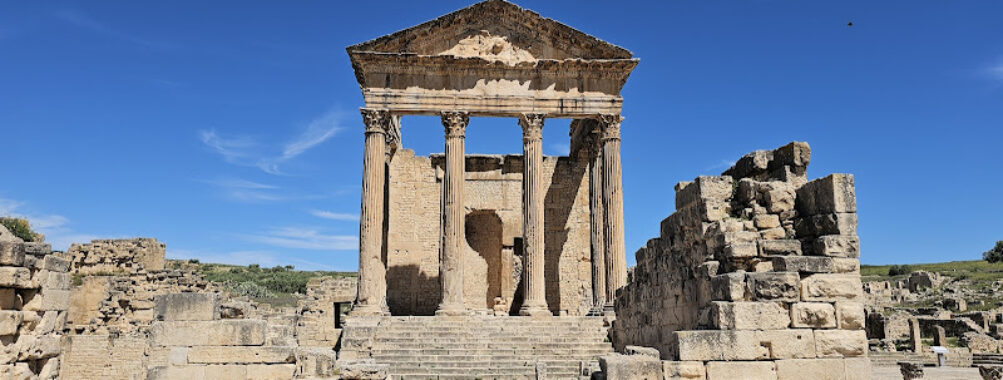
Dougga
Table of Contents
Description
Let me tell you about Dougga – it’s honestly one of the most jaw-dropping ancient Roman cities I’ve ever explored in North Africa. This UNESCO World Heritage site sprawls across a hilltop in Tunisia, and trust me, the panoramic views alone are worth the journey. Walking through these incredibly preserved ruins feels like stepping into a time machine – I still remember the first time I rounded a corner and came face-to-face with that magnificent theater, its semi-circular rows rising against the sky.
What makes Dougga extra special is how complete it feels. You’re not just looking at a few scattered columns here and there. Instead, you get to explore an entire ancient city, from its grand public buildings down to its intimate residential quarters. The Capitol temple stands proud on its platform, while the curves of the theater could honestly rival some modern venues I’ve seen. And y’know what? The acoustics are still amazing – I couldn’t resist belting out a tune when no one was around!
Key Features
• The Roman Theater – An absolute masterpiece that could seat 3,500 people, with seriously impressive acoustics still intact
• Capitol Temple – A massive structure dedicated to Rome’s most important deities
• Arch of Alexander Severus – A beautifully preserved triumphal arch that’ll make your photos pop
• The Forum – Once the beating heart of city life, surrounded by important buildings
• Antonian Temple – With its distinctive columns still reaching skyward
• Public Baths – Complete with underground heating systems (those Romans were clever!)
• The Market – Where you can almost imagine the bustle of ancient shopping days
• Numerous private villas – Some still showing traces of gorgeous mosaic floors
• Ancient streets – Still lined with their original stone paving
• The Numidian Mausoleum – A fascinating blend of Greek, Egyptian and local architectural styles
Best Time to Visit
Take it from someone who learned the hard way – timing your visit to Dougga is crucial. Spring (March to May) and autumn (September to November) are absolutely perfect. The temperatures hover around 20-25°C (68-77°F), making it comfortable to explore without melting in the Tunisia heat. I made the mistake of visiting in August once, and whew, those stones really hold the heat!
Early mornings or late afternoons offer the best light for photography, plus the site is usually less crowded then. If you can, try to arrive just as they open – there’s something magical about watching the sunrise paint those ancient stones in gold. Avoid midday visits during summer months unless you’re particularly fond of scorching heat (and trust me, you’re not).
How to Get There
Getting to Dougga requires a bit of planning, but it’s totally worth the effort. The site sits about 65 miles southwest of Tunis, and you’ve got several options to reach it. I personally recommend hiring a driver or joining a guided tour from Tunis – it’s the easiest way and you’ll get some great local insights during the journey.
If you’re feeling adventurous (like I was on my first visit), you can rent a car and drive yourself. The roads are decent, though signage can be a bit spotty. Public transportation is possible but tricky – you’d need to combine several local buses and probably a taxi for the final stretch.
Tips for Visiting
Okay, here’s where my experience really comes in handy. First off, wear sturdy shoes! The site is huge and the ground is uneven – those ancient streets weren’t built with modern comfort in mind. I learned this lesson after nearly twisting my ankle on my first visit.
Bring plenty of water and snacks. While there’s a small cafe near the entrance, you’ll want supplies with you as you explore. The site is massive, and you’ll easily spend 3-4 hours wandering around. Pack a hat and sunscreen too – there’s limited shade among the ruins.
Consider hiring a guide at the entrance. The site doesn’t have many information panels, and having someone explain the history and significance of each building really brings the place to life. I skipped this on my first visit and totally regretted it.
Take your time exploring the less-visited areas. While the theater and Capitol are stunning, some of my favorite discoveries were in the quieter corners – like the tiny shrine with worn carvings that most tourists walk right past.
Bring a good camera if you can. The light here is incredible, especially during golden hour, and the photo opportunities are endless. Oh, and don’t forget to climb up to the highest point of the site – the view of the entire ancient city with the countryside beyond is absolutely breathtaking.
Last but not least, remember that this is an active archaeological site. Respect the barriers and don’t climb on the ancient structures (no matter how tempting those photo ops might be). We want to keep this incredible piece of history intact for future generations to enjoy!
Location
Places to Stay Near Dougga
Find and Book a Tour
Explore More Travel Guides
No reviews found! Be the first to review!